Coat (dog)

The coat of the domestic dog (Canis lupus familiaris) refers to the hair that covers its body. A dog's coat may be a double coat, made up of a soft undercoat and a tougher topcoat, or a single coat, which lacks an undercoat. Double coats have a top coat, made of stiff hairs to help repel water and shield from dirt, and an undercoat to serve as insulation.[1] The terms fur and hair are often used interchangeably when describing a dog's coat, however in general, a double coat, e.g., like that of the Newfoundland and most mountain dogs, is referred to as a fur coat, while a single coat, like that of the Poodle, is referred to as a hair coat.
Genetics

There are a greater variety of coat colors, patterns, lengths and textures found in the domestic dog than in its wolf relations, as is typical of all domestic animals. In the wild, mutations often put animals at some practical disadvantage decreasing survival or reducing their attractiveness to the opposite sex; whereas domestic animals are protected from harm, and bred from specifically due to practical applications of the mutation for human uses, or to the attraction man has for uniqueness.
During evolution of the dog from their wild wolf ancestors, coat colors in dogs were probably the inadvertent outcome of some other selective process (i.e., selection for tameness), and were not likely initially selected for intentionally by humans.[2] Research has found that tameness brings associated physical changes, including coat colouring and patterning.[3] Diversification of the dog into different types and ultimately separate breeds increased colour variation as factors such as camouflage and visibility aided the dogs’ functionality.
Coat types were selected for, both inadvertently and intentionally, in accordance with factors such as climate, vegetation in the dogs’ working environment, and the need to perform tasks in water.
Domestic dogs often display the remnants of countershading, a common natural camouflage pattern. The basic principle of countershading is when the animal is lit from above, shadows will be cast on the ventral side of the body. These shadows could provide a predator or prey with visual cues relating to the movement of the animal. By being lighter colored on the ventral side of the body, an animal can counteract this, and thereby fool the predator or prey. An alternative explanation is that the dorsal and ventral sides of an animal experience different selection pressures (from the need to blend into different backgrounds when viewed from above and below) resulting in differing coloration.[4]
Nomenclature of colors and patterns
Colors
The same color may be referred to differently in different breeds. Likewise, a same term may mean different colourations in different breeds.
- Brown, chocolate, liver
Brown, chocolate and liver are the most common terms used to refer to the bb-dilution of black pigment to a dark brown. Depending on breed and exact shade, terms such as mahogany, midtone brown, grey-brown, blackish brown are used. Sedge and deadgrass are used to describe the desired Chesapeake Bay Retriever color that resembles "that of its working surroundings" as closely as possible.
 Brown Chesapeake Bay Retriever
Brown Chesapeake Bay Retriever
 Dark and light chocolate Labrador Retrievers
Dark and light chocolate Labrador Retrievers
- Red
Red refers to reddish shades of orange, brown, and tan. Terms used include orange, red-gold, cinnamon, tan, and ruby. Genetically a dog called red is usually a clear sable (with little to no eumelanin tipping on hairs) or a ruddy recessive yellow.
In some breeds, "red" refers to what would usually be called brown, chocolate, or liver. A "red merle" is always a liver-based merle. In Australian Cattle Dogs, blue stands for a densely ticked liver-based colouration with an overall red-grey appearance.
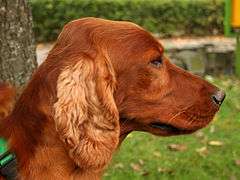 Red Irish Setter
Red Irish Setter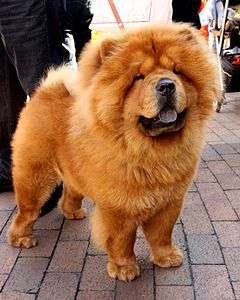 Red Chow Chow
Red Chow Chow.jpg) Red Standard Poodle
Red Standard Poodle
- Red Australian Cattle Dog
- Gold and yellow
Gold refers specifically to a rich reddish-yellow and its variants, whereas yellow can refer to any shade of yellow and tan. Terms used include yellow-gold, lion-colored, fawn, apricot, wheaten, tawny, straw, yellow-red, mustard, sandy, honey, apricot, blond, lemon. Dogs called golden or yellow tend to be recessive yellow, but can also be sable.
 Apricot Poodle
Apricot Poodle- Dark Golden Retrievers
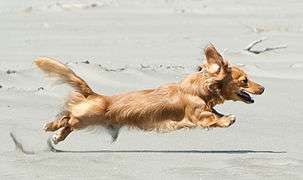 Yellow Dachshund
Yellow Dachshund Yellow Labrador Retriever
Yellow Labrador Retriever
- Cream
Cream refers to a pale yellowish or tannish colour which can be almost white.
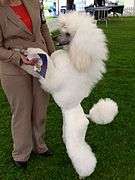 Pale cream Standard Poodle
Pale cream Standard Poodle Cream French Bulldog
Cream French Bulldog Cream Akita
Cream Akita
- Fawn
Fawn typically refers to a yellow, tan, light brown, or cream dog that has a dark melanistic mask.
With Weimaraners, fawn refers to their typical brownish grey colouration that with other breeds is usually called lilac.
 Fawn Pug
Fawn Pug- Fawn English Mastiff
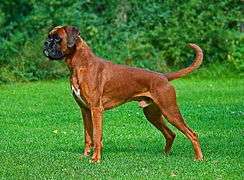 Fawn Boxer
Fawn Boxer
- Black
Black is a pure black that can get grizzled as the dog ages, or have a tendency to gain a brownish cast when exposed to the elements.
 Black Labrador Retriever
Black Labrador Retriever
- Blue
Blue is a cool-toned, metallic grey. It typically means a d/d dilution of black pigment, a grey colouration that is grey from birth, but has a wide range of breed-specific meanings.
In Kerry Blue Terriers, Poodles, and Bearded Collies, "blue" refers to colouration that is black at birth and progressively greys out as the dog matures. In Australian Shepherds, Rough Collies, and Shetland Sheepdogs, blue means a blue (black-based) merle. In Australian Silky Terriers, blue means a saddle-type black and tan pattern, where the black parts of the coat progressively fade to a steel grey as the dog matures, and in Australian Cattle Dogs, blue stands for a densely ticked black-based colouration with an overall blue-grey appearance.
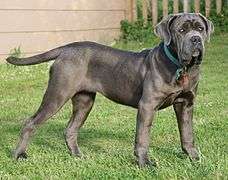 Blue Neapolitan Mastiff
Blue Neapolitan Mastiff Blue mixed-breed dog
Blue mixed-breed dog
- Blue Australian Cattle Dog
- Grey
Grey simply means a grey colouration of any shade. It can be used as an alternative synonym of blue, but tends to mean some other type of grey than the d/d dilution of black. Synonyms include silver, pepper, grizzle, slate, blue-black grey, black and silver, steel. Greys of a dusty or brownish cast are often lilac, a d/d dilution of liver, and this colouration does not have much of a commonly recognised name. Across various breeds, it is called lavender, silver-fawn, isabella, fawn, café au lait or silver beige.
In Poodles, a blue is a very slowly fading, very dark steel grey, whereas a silver is a quicker to clear, much lighter grey that can range from a pale platinum to a steel grey. Both are black at birth with minimal markings to indicate future change. Similarly, café au lait is a slower and darker and silver beige a quicker and lighter progressively greying brown, i.e. liver.
- Lighter and darker fawn Weimaraners
 Silver Miniature Schnauzer
Silver Miniature Schnauzer Silver Miniature Poodle
Silver Miniature Poodle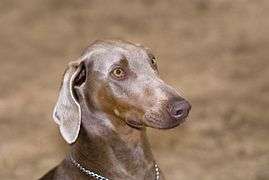 Isabella/fawn Dobermann
Isabella/fawn Dobermann
- White
White: Such a light cream that it is seen and described as pure white, making them distinct from albino dogs. A white dog, as opposed to an albino one, has dark pigment around the eye rims and nose, often coupled with dark-colored eyes. There is often some coat identifiable as cream between the dog's shoulder blades.
 White American Eskimo Dog
White American Eskimo Dog White Bichon Frisé
White Bichon Frisé
Patterns
The same pattern may be referred to differently in different breeds.
 Liver and tan Australian Kelpie |
 Black and tan Rottweiler |
Black and tan, liver and tan, blue and tan: Coat has both colors but in clearly defined and separated areas, usually with the darker color on most of the body and tan (reddish variants) underneath and in highlights such as the eyebrows. Black and brindle and liver and brindle, in which the same pattern is evident with brindling in place of tan, are also possible, but less common. |
 Black and white Border Collie |
 Blenheim (Red-brown and white) Cavalier King Charles Spaniel |
Bicolor (also called Two-color, Irish spotted, Flashy, Patched, Tuxedo) Any color or pattern coupled with white spotting. This can range anywhere from white toes and tail tip to a mostly white dog with color around the base of the ears and tail. Some breeds have special names for the color combinations; for example, Cavalier King Charles Spaniel uses Blenheim for reddish brown (chestnut) and white. Irish Spotted or flashy pattern is symmetrical and includes a white chest, white band around the neck, white belly, and white feet or "boots." This pattern is commonly seen in herding dogs, and Boxers, among others. The piebald gene is responsible for this pattern. |
 Black tricolor Entlebucher Mountain Dog |
 Tricolor Beagle |
Tricolor: Three clearly defined colors, usually either black, liver, or blue on the dog's upper parts, white underneath, with a tan border between and tan highlights; for example, the Smooth Collie, the Rough Collie, the Papillon,or the Sheltie. Tricolor can also refer to a dog whose coat is patched, usually two colors (such as black and tan) on a white background. |
 Blue merle tricolor Shetland Sheepdog |
 Red merle Catahoula Leopard Dogs |
Merle: Marbled coat with darker patches and spots of the specified color. Merle is referred to as "Dapple" in Dachshunds. |
 Tuxedo Lab mix. |
 Tuxedo Collie mix |
Tuxedo: Solid (often black) with a white patch (shirt front) on the chest and chin, and white on some or all of the feet (spats.) The tuxedo pattern is common in dogs that carry only one piebald gene (a heterozygous carrier). |
 Harlequin Great Dane |
 Harlequin Great Dane |
Harlequin: "ripped" splotches of black on white. The Great Dane is the only breed with this pattern. The term harlequin is also sometimes used to describe a piebald spotting pattern, such as parti-colored poodles. |
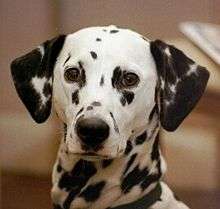 Spotted Dalmatian |
 Spotted mutt in Sinamaica, Venezuela |
Spotted Coin-sized pigmented spots on a white background. The spotting on Dalmatians is unique as it involves mutations in at least three different spotting genes.[5] |
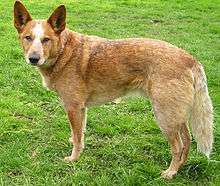 Red-speckled Australian Cattle Dog |
 Liver-ticked German Shorthaired Pointer |
Flecked, ticked, speckled: also called belton in English Setters |
| Orange belton (orange and white speckled) English Setter |
 Blue speckled Australian Cattle Dog | |
 Densely brindled liver and white Boston Terrier |
 Very sparsely brindled Great Dane |
Brindle: A mixture of black/liver/blue/lilac and red/yellow/cream arranged in a vertical "tiger stripe" pattern. |
 Airedale Terrier with large black saddle |
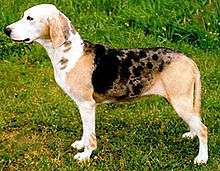 Norwegian Dunker with merle-affected black saddle |
Saddle or blanket: A different color, usually darker, over the centre of the back. |
 Dark orange sable Pomeranian |
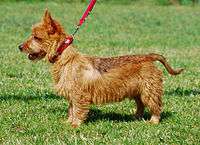 Clear sable Australian Terrier |
Sable: Black-tipped hairs; the rest of the hair can be gold to yellow, silver, grey, or tan. The darkness of the coat depends on how much of each hair is black versus the lighter color. Totally clear sables might only have black in their whiskers. |
Show coats
The nature and quality of a purebred dog's coat is important to the dog fancy in the judging of the dog at conformation shows. The exact requirements are detailed in each breed's breed standard and do not generalise in any way, and the terminology may be very different even when referring to similar features. See individual breed articles for specific information.
Shedding
Shedding can occur continuously, but in many breeds is strongly influenced by hormones. Seasonal shedders shed most in spring and fall, following an increase or decrease in day length, and least in summer and winter, in response to constant day length. Cold temperatures stimulate hair growth, so that the heaviest shedding is in spring on dogs living in cold climates. Artificial lighting can alter the seasonal shedding pattern of dogs who live indoors. Other hormonal influences include dietary factors, reproductive hormones in intact dogs, and various medical conditions and disorders. Shedding that is done in a short period of time is known as "blowing the coat" or "blowing coat".[6][7] Among the other coat types, dogs with fine silky coats (e.g., spaniels) are generally moderate shedders, those with an intermediate coat texture (e.g., mountain dogs) are generally heavy shedders, and those with thick stand-offish coats (e.g., spitzes) are generally very heavy shedders.
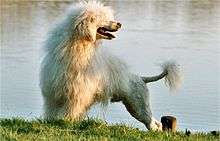
"Non-shedding" dogs have greatly-reduced shedding due to alterations to the hair follicle growth cycle:
- homozygosity for the furnishings (wire) allele - Most breeds with facial furnishings (including ones whose faces are usually shaved removing the furnishings!) are low-shedding, but they must be homozygous, so dogs of mixed wire/non-wire parentage (e.g., terrier crosses or breeds with wire and non-wire varieties) can be heavy shedders. There are a few furnished breeds that shed more (e.g., Old English Sheepdog, Bearded Collie, Briard, Otterhound);
- at least one copy of the single-coat (non-shedding) allele - Most dogs with a smooth coat are low shedding, as well as the fringed or flat coat. There are breeds with a very short coat that shed more (e.g., Basset Hound, English Bulldog, Pug, Toy Fox Terrier, Dalmatian, Vizsla, German Shorthaired Pointer);
- single coat (no undercoat) plus furnishings (homozygous) - These breeds shed the least (e.g., Poodle, Soft-coated Wheaten Terrier). No exceptions.
Hypoallergenic coat
Some dog breeds have been promoted as hypoallergenic (which means less allergic, not free of allergens) because they shed very little. However, no canine is known to be completely nonallergenic. Often the problem is with the dog's saliva or dander, not the fur.[8] Although breeds such as poodles, bichons, yorkies, and wire-haired terriers are commonly represented as being hypoallergenic due to reduced shedding, the reaction that an individual person has to an individual dog may vary greatly. In management of dog-related allergies, it has been found that "Factors related to individual dogs seem to influence the allergenicity more than breed..."[9]
See also
Notes
References
- ↑ "How to Keep Your Dog Warm This Winter". Spoiled Pets Shop. 2014. Retrieved November 10, 2014.
- ↑ James Serpell, ed. (1995). The Domestic Dog: Its Evolution, Behaviour and Interactions with People. Cambridge, United Kingdom: Cambridge University Press. p. 284. ISBN 0-521-42537-9.
- ↑ Lyudmila N. Trut (March–April 1999). "Early Canid Domestication: The Farm-Fox Experiment". American Scientist. 87 (2): 160–169. doi:10.1511/1999.2.160.
- ↑ Graeme D. Ruxton; Michael P. Speed; David J. Kelly (September 2004). "What, if anything, is the adaptive function of countershading?". Animal Behaviour. 68 (3): 445–451. doi:10.1016/j.anbehav.2003.12.009.
- ↑ Edward J. Cargill1, Thomas R. Famula, Robert D. Schnabel, George M. Strain & Keith E. Murphy (July 2005). "The color of a Dalmatian's spots: Linkage evidence to support the TYRP1 gene". BMC Veterinary Research. 1 (1): 1. ISBN 1-74661-481-1. PMC 1192828
 . PMID 16045797. doi:10.1186/1746-6148-1-1.
. PMID 16045797. doi:10.1186/1746-6148-1-1. - ↑ Blackburn, Sandy (2008). The Everything Dog Grooming Book: All you need to help your pet look and feel great!. Avon, Massachusetts: Simon & Schuster. p. 110. ISBN 1440512140. Retrieved 2017-07-04.
- ↑ Dog Fancy (2011). Pug. New York: Lumina Media. p. 36. ISBN 1593788398. Retrieved 2017-07-04.
- ↑ Grady, Denise (February 5, 1997). "Nonallergenic Dog? Not Really". New York Times. Retrieved April 3, 2011.
- ↑ Heutelbeck AR, Schulz T, Bergmann K, Hallier E (Jan 2008). "Environmental Exposure to Allergens of Different Dog Breeds and Relevance in Allergological Diagnostics". Journal of Toxicology and Environmental Health, Part A. 71 (11–12): 751–8. PMID 18569573. doi:10.1080/15287390801985513.
Further reading
- Cunliffe, Juliette (2004). "Coat Types, Colors and Markings". The Encyclopedia of Dog Breeds. Paragon Publishing. pp. 20–23 and various. ISBN 0-7525-8276-3.
- Fogle, Bruce (2000). "The Breed Section Explained". The New Encyclopedia of the Dog. Dorling Kindersley. p. 83 and various. ISBN 0-7513-0471-9.
External links
- Schmutz, Sheila M. (March 4, 2010). "Dog Coat Color Genetics". University of Saskatchewan. Retrieved September 12, 2010.